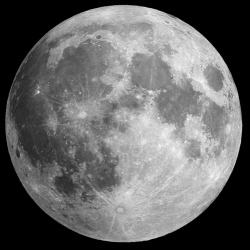
A smattering of water is buried deep inside the Moon and it arrived during the satellite’s very early history, a new study concludes, when water carrying asteroids plunged into the churning oceans of magma. How and when water got trapped in volcanic lunar rocks is a huge and open question for planetary scientists.
This international team has compared the chemistry of Apollo mission samples with various types of space rock. They say that icy, early asteroids were the likely source of most of the water. After such impacts the Moon’s developing crust could have trapped the water in the cooling magma.
Much later, volcanic activity spewed some of that magma back onto the surface and, much later again, a precious few of those volcanic rocks were bagged by Apollo astronauts. Tightly bound up in the rocks is a trace of water: somewhere between 10 and 300 parts per million (0.001-0.03%).
"It’s not pools of water, it’s not lakes of water, it’s not frozen ice. When we’re talking about interior – or magmatic – water, we’re talking about water that is locked up in minerals," said Dr Jessica Barnes from the Open University in the UK, first author of the new paper in Nature Communications.
The source of that water is a topic of ongoing debate. Previous research revealed that some of these watery deposits have a similar molecular signature to water-rich "carbonaceous chondrite" meteorites that occasionally reach the Earth from the asteroid belt.
So was water brought to the Moon by chunks of asteroid? Perhaps via the very early Earth, which was similarly bombarded before the brutal collision that created our satellite? Or, as other researchers have suggested, did lunar water arrive in comets – the Solar System’s more distant, icy travellers?
Working with colleagues in the US and France, Dr Barnes modelled various scenarios to explore what could have produced the chemistry of the Moon’s water as we know it. To run these tests, they surveyed all the published results about the make-up of lunar rock samples and various possible contributors – from Earth rock to comets.
"We’ve taken an approach that’s the most quantitative so far, in terms of deciphering which types of objects would have been impacting the Moon," she told BBC News. For starters, her models suggest that comets probably contributed only a tiny fraction of the sub-surface water.
This is largely because comets appear to have "heavier" water – containing more deuterium, a heavy hydrogen isotope – than either Earth, the Moon or asteroids, Dr Barnes explained.
"Our conclusion is it was mostly water-rich asteroids and very, very little contribution from comets," she said.
In particular, her findings point to asteroids with a recipe much like carbonaceous chondrites. These rocks, which today make up up less than 5% of known Earth impacts, have characteristics that seem to reflect "primitive" asteroids.
